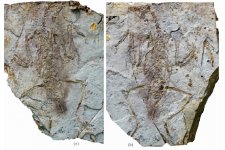albertonykus
Well-known member
Wang, X., S. Ju, W. Wu, Y. Liu, Z. Guo, and Q. Ji (2022)
The first enantiornithine bird from the Lower Cretaceous Longjiang Formation in the Great Khingan Range of Inner Mongolia
Acta Geologica Sinica (advance online publication)
This article reports the first enantiornithine bird from the Lower Cretaceous Longjiang Formation at the Pigeon Hilllocality of Morin Dawa Daur Autonomous Banner, Hulunbuir City, Inner Mongolia. To ascertain the anatomical characters and phylogenetic position, the specimen was described in detail and compared with other Mesozoic birds. Phylogenetic analyses were performed in TNT. The new specimen is most similar to Bohaiornithidae in the expanded omal end of the furcular ramus, the gently tapered distal end of the pygostyle, the caudolaterally oriented lateral trabecula of the sternum, and a robust second pedal digit. It is further distinguishable from other known bohaiornithids by possessing the following unique combination of features, such as the lateral margin of the coracoid prominently expands from the middle part; the sternum possesses a triangular intermediate trabecula, a small notch on the lateral margin and a relatively sharp cranial margin; and the alular manual ungula is long and recurved, whereas the major manual ungual is short and robust. Therefore, we erect a new taxon of Bohaiornithidae-Beiguornis khinganensis gen. et sp. nov.. Phylogenetic analyses show that Beiguornis is most closely related to Sulcavis and Zhouornis of Bohaiornithidae, and these three taxa form a monophyletic clade(Zhouornis+‘Beiguornis+Sulcavis’). Except for Longusunguis, other taxa of Bohaiornithidae and Beiguornis are included within a monophyletic clade, which further ascertains the phylogenetic position of Beiguornis within Bohaiornithidae. Beiguornis khinganensis represents the first occurrence of enantiornithine bird in the Great Khingan Range and enriches the biological combination of the Jehol Biota in this area. It further enriches the diversity of bohaiornithids, expands the geographic distribution of bohaiornithids from northern Hebei and western Liaoning to the Great Khingan Range in Inner Mongolia, and provides the low-taxonomic correlations with the Jehol Biota in different areas using the same order-clade of fossil birds.
(I do not have the PDF yet, but it should be open access on the journal website when the print version is released.)
The first enantiornithine bird from the Lower Cretaceous Longjiang Formation in the Great Khingan Range of Inner Mongolia
Acta Geologica Sinica (advance online publication)
This article reports the first enantiornithine bird from the Lower Cretaceous Longjiang Formation at the Pigeon Hilllocality of Morin Dawa Daur Autonomous Banner, Hulunbuir City, Inner Mongolia. To ascertain the anatomical characters and phylogenetic position, the specimen was described in detail and compared with other Mesozoic birds. Phylogenetic analyses were performed in TNT. The new specimen is most similar to Bohaiornithidae in the expanded omal end of the furcular ramus, the gently tapered distal end of the pygostyle, the caudolaterally oriented lateral trabecula of the sternum, and a robust second pedal digit. It is further distinguishable from other known bohaiornithids by possessing the following unique combination of features, such as the lateral margin of the coracoid prominently expands from the middle part; the sternum possesses a triangular intermediate trabecula, a small notch on the lateral margin and a relatively sharp cranial margin; and the alular manual ungula is long and recurved, whereas the major manual ungual is short and robust. Therefore, we erect a new taxon of Bohaiornithidae-Beiguornis khinganensis gen. et sp. nov.. Phylogenetic analyses show that Beiguornis is most closely related to Sulcavis and Zhouornis of Bohaiornithidae, and these three taxa form a monophyletic clade(Zhouornis+‘Beiguornis+Sulcavis’). Except for Longusunguis, other taxa of Bohaiornithidae and Beiguornis are included within a monophyletic clade, which further ascertains the phylogenetic position of Beiguornis within Bohaiornithidae. Beiguornis khinganensis represents the first occurrence of enantiornithine bird in the Great Khingan Range and enriches the biological combination of the Jehol Biota in this area. It further enriches the diversity of bohaiornithids, expands the geographic distribution of bohaiornithids from northern Hebei and western Liaoning to the Great Khingan Range in Inner Mongolia, and provides the low-taxonomic correlations with the Jehol Biota in different areas using the same order-clade of fossil birds.
(I do not have the PDF yet, but it should be open access on the journal website when the print version is released.)





